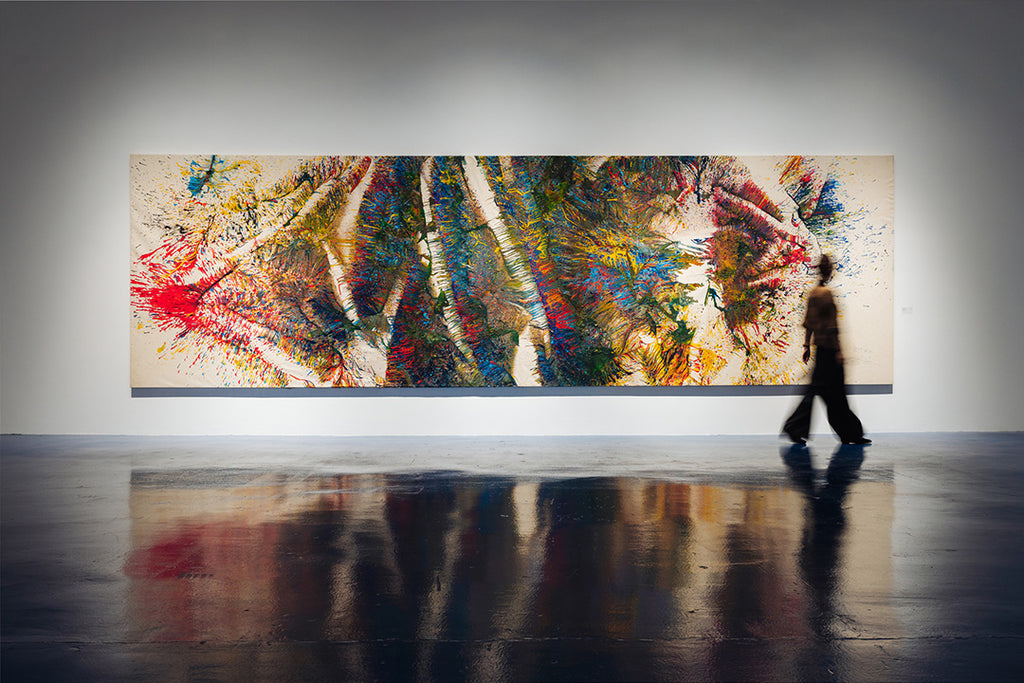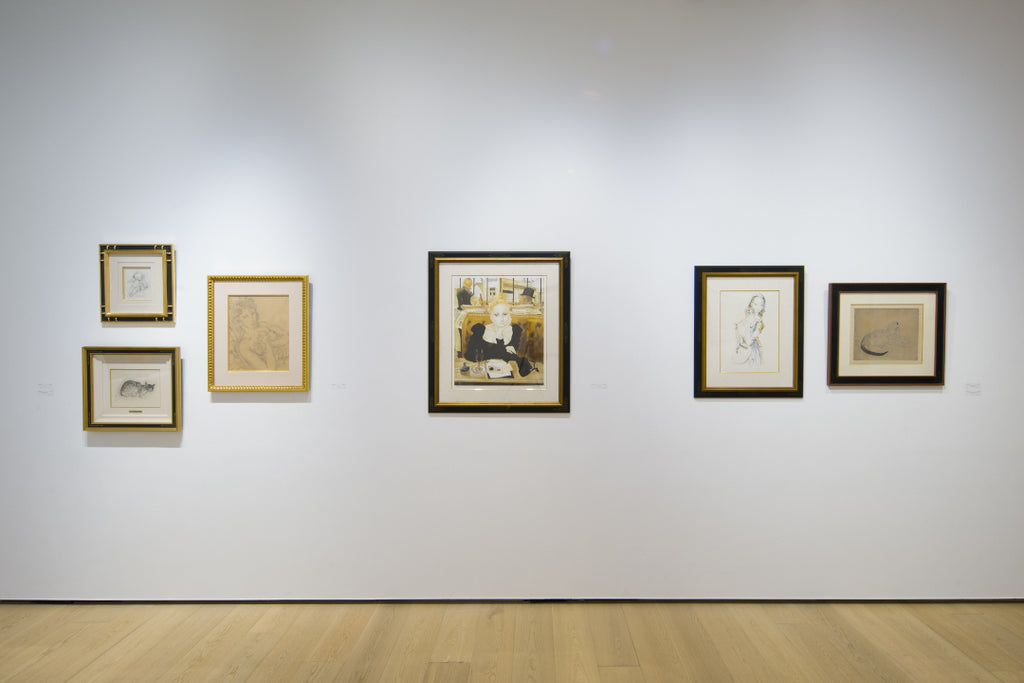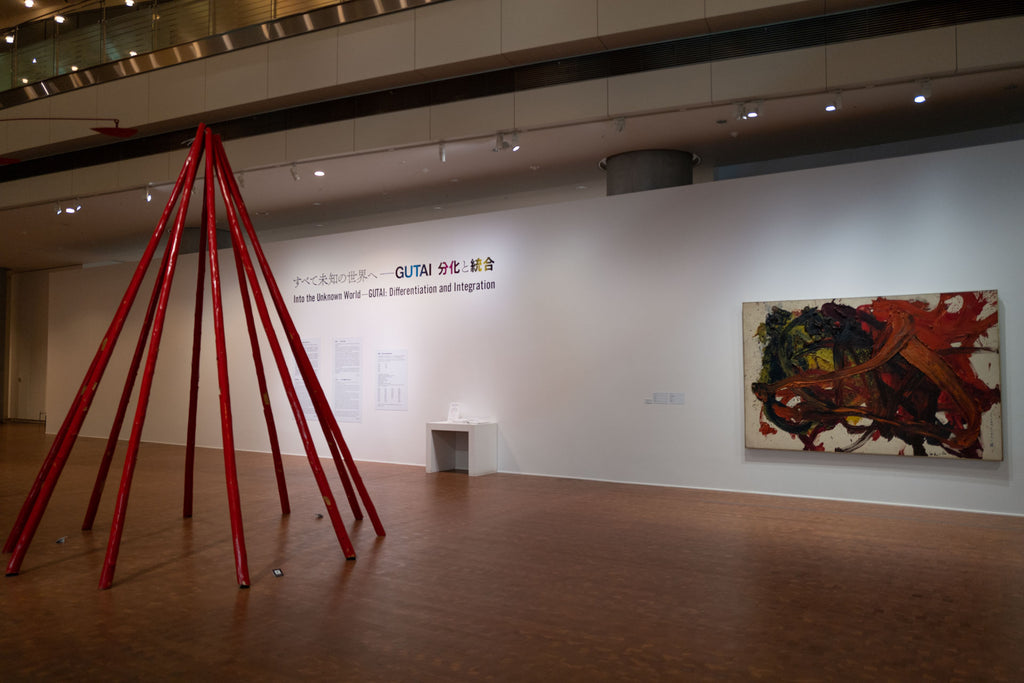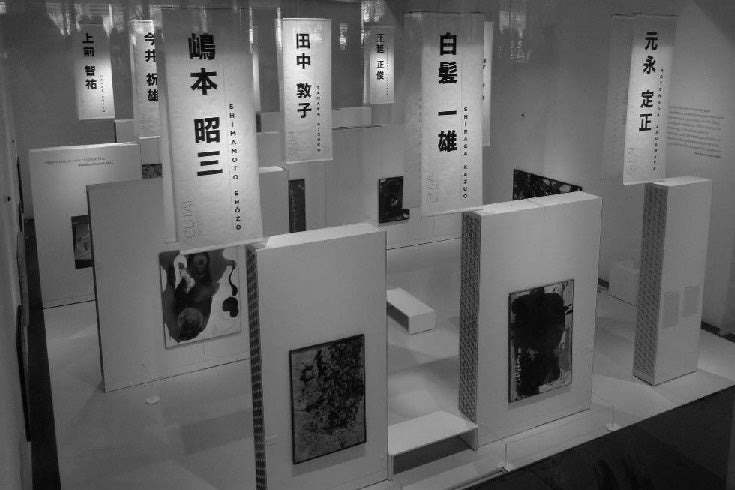ARTICLES
Art Historian Kunio Motoe’s Take On the “Gutai Art Association”
GUTAI STILL ALIVE 2015 vol.1
01/35

A project evolving the digitized archive of the book, “GUTAI STILL ALIVE 2015 vol.1”. The first article is by Kunio Motoe, an art historian and professor at Tama Art University, who describes his view on the Gutai Art Association.
A Note on Gutai
Kunio Motoe
Professor, Tama Art University
Thanks in part to “Gutai: Splendid Playground,” a large-scale retrospective of Gutai Art Association (1954-72) at the Solomon R. Guggenheim Museum in 2013, Gutai art is gaining its own position and appreciation in mainly Western postwar art history, distinctively from such simultaneous and similar art movements as Art informel and Abstract Expressionism – a fact at which I am highly pleased. However, such historical recognition is apt to be biased by preconceptions of the time that are often distorted or simplified, albeit not totally false.
While I was reading the other day Evelyn Toynton’s “Jackson Pollock” (a title from Yale University Press’ Icons of America series), I came across the phrase: “The Japanese Gutai artists were engaging in body art performances that were inspired by the photographs and films of Pollock painting.” 1) Pollock’s “Number 11, 1949” was exhibited at the 3rd Yomiuri Independent Exhibition in 1951 and featured on the cover of the Mizue art magazine of the April issue of that year. Jiro Yoshihara, head of Gutai, mentioned the artist in his “Gutai Art Manifesto,” published in the December 1956 issue of the Geijutsu Shincho art magazine, saying, “Contemporary art pays respect to the work of Jackson Pollock, Georges Mathieu, among others.” Nevertheless, it is not fair to regard Gutai art as something under the overwhelming influence of Pollock (all the worse as the book, written for the general public, is basically a good job). In fact, the “respect” of Yoshihara was of the kind that artists would pay to their fellow artists. Informel promoter Michel Tapié also wondered at the existence of true Informel in Japan already in 1957, when he visited this Far Eastern archipelago.
“Parallelism” in art movements would be natural when we consider the worldwide postwar passion for filling the hiatus in art brought about by the war. But the hegemonic parties of contemporary art don’t necessarily think so. In 1958, when Gutai was first introduced at Martha Jackson Gallery in New York, William Rubin, a disciple of Clement Greenberg, while referring to the freedom in Japanese society (as the result of Japan’s elusion of Communism) reflected in Gutai’s work, criticized “the Dada antics of the Gutai and their overtly derivative Abstract- Expressionist paintings.” 2) That seems almost a false charge, although he might not have been well informed.
First of all, what is Gutai? Tearing paper (Saburo Murakami), muddling paint with feet (Kazuo Shiraga), throwing bottles of paint (Shozo Shimamoto), wearing a dress made of electric bulbs (Atsuko Tanaka), among other eccentricities and performances, characterized this free artistic movement reflecting a free postwar society as opposed to the totalitarian times before and during the war. This point of view is especially common in the West, but we should not approve it easily. For what has made Gutai as it is today is chiefly “painting.” A prestigious Oxford dictionary of art characterizes Gutai art as performance and “abstract painting, mainly in an Abstract Expressionist vein.” But I do not think it proper that it characterizes Gutai’s painting as Abstract Expressionist. Because, with the sole exception of Chiyu Uemae, who painstakingly accumulates simple action based on his own body, the essence of Gutai’s painting lies in the way the work is finished at a stretch by a sort of instantaneous force deriving from “their practice upon the medium of paint and the act of painting.” 3) In this, it differs distinctly from Abstract Expressionist painting, which underwent the process of “construction” more or less.
It is true that, against Modernism, in which color and form were developed autonomously, Yoshihara declared in the Gutai Art Manifesto, “We want to do bolder, more active work. What is important is not the result, but the action that leaves traces of oneself in the materials, I believe.” And what is most significant here is Yoshihara’s inner animistic sense of materiality, which is evident in the following phrase from the manifesto:
Gutai art does not transform matter. It gives life to matter. It does not falsify matter.
In Gutai art, human spirit and matter join hands while conflicting with each other. Spirit does not subordinate matter. When matter has revealed its essence as it is, it starts narrating and even cries out. To make the most of matter is a way to make the most of spirit. To heighten spirit is to introduce matter into the lofty stage of spirit.
Spirit and matter coexist and confront each other on equal terms. At the 1st Gutai Art Exhibition at Ohara Kaikan in Tokyo in 1955, Kazuo Shiraga played and struggled with approximately 1 ton of mud, crawling on the floor. So we cannot identify him with Pollock, who used to drip paint – in fact – precisely, looking down on the canvas on the floor. In Pollock’s case, there was obviously the priority of spirit to matter. What is intriguing is that – I wonder if I am the only one who feels this way – as I watch Shiraga doing the work in a documentary film, I find myself having an illusion that the mud was paint. What is even more intriguing is that when I put a photograph of Shiraga covered all over with mud next to a painstakingly pointillistic painting by Uemae produced in the same period, they harmonize with each other perfectly. 4) There would be the beginning of an aesthetic and concrete state of affairs that was nothing less than exchange or relationship between materials, media (paints), the body and spirit, from which Shiraga would later go on to paint with his feet and Uemae would sew his unique objects.
By the way, what is Gutai? Each one may have their own point of view. Shigenobu Kimura, for example, says concerning Gutai, “They no longer cared about the style, whether it was abstraction or representation. They automatically layered various materials on the picture surface and sought a passage not in the internal ideas but in external materials, while, moreover, seeking to transform themselves into a flow of vivid life,” 5) citing the notion of “couleur-objet,” that is, a general denial of the linguistic nature of color, from Jean-Paul Sartre’s “What Is Literature.” It is a remarkable view that describes the very liveliness of Gutai. While I respect it, I would like to attach importance to the definite words of Theo van Doesburg (1883-1931), “It should receive nothing from Nature’s formal properties or from sensuality or sentimentality” 6) (1930), about his “L’Art concret” or “Concrete Art.” For I think it is a stricter version of Yoshihara’s motto, “Make something that has never been.”
A total denial of art’s affinity with nature is like creating another nature. It is in this context that we should understand Hans Arp (1886-1966), who hated that his unique organic forms should be called abstract, arguing that, as wood has its own shape, his works are concrete. Also, we should not forget that even Greenberg had a latent “concrete” sense as he mentioned, somewhat unexpectedly and almost dreamily at that point of history, in that breakthrough essay “Avant-Garde and Kitsch” (1939), “something valid solely on its own terms, in the way nature itself is valid, in the way a landscape – not its picture – is aesthetically valid.” 7) The question is whether our Gutai was involved in the narrative of “another nature” that regards an artist as a virtual god. To this question I cannot answer promptly. Anyhow, I feel we need to define the question of animism in order to do fruitful discussions about this matter.
I cited van Doesburg and Greenberg because we can often see a “second nature” or concrete art in Gutai also. In addition to Shiraga and Uemae, the work of Tsuyoshi Maekawa (who instantly turns nonaesthetic, banal objects into surprising things), Shuji Mukai (who sticks to original, self-mentioning [non]signs that remake the realities) and Yuko Nasaka (who ultimately concretized the circle form with which she became familiar seeing meters manufactured in her father’s factory) all hint at such a second nature. Especially remarkable is Atsuko Tanaka’s bold and truly concrete sensibility toward reality that made her call the “work” in which she rang the bells installed in the exhibition space at certain intervals “painting.” At that point the sounds were pigments and the space a picture surface with concrete depth. Seiko Kanno, who repeated geometric motifs in an authentically – in the Western sense – “concrete” manner, also belonged to Gutai.
Now, as I look at Gutai artwork, I am reminded of its depth. Rather than a constellation composed of bright stars, it reminds me of a shining nebula. We can still expect something to come out of it. Whatever, I imagine, how those unique Gutai artists enjoyed their everyday work and life freely in Gutai or a “place to recover the modern ego lost in the war” (Shoichi Hirai). 8)
Annotation1) E. Toynton, Jackson Pollock, Yale UP, 2012, p.77
2) W. Rubin, “The New York season begins,” Art International 2 (December 1958), p.27, quoted by M. Tiampe, “Cultural Mercantilism: the Gutai Group,” in J. Harris (ed.), Globalism and Contemporary Art, John Wiley & Sons, 2011, p.215
3) J. Kee, “Situating a Singular Kind of ‘Action’: Early Gutai Painting, 1954-57,” Oxford Art Journal, nol.26 no.2 (2003), p.158
4) Gekkan Bijutsu, August 2013, p.32
5) Shigenobu Kimura, “The Pioneering Significance of ‘Gutai’ in Postwar Art History,” Shoichi Hirai, “What Is ‘Gutai’?’’ (Bijutsu Shuppan Sha, 2004), p.10
6) Dictionnaire de l’art moderne et contemporain, Hazan, 2002, p.208
7) Harrison and Wood, Art in Theory 1900-1990, Blackwell, p.531
8 ) Gekkan Bijutsu, ibid., p.35
Read more about the “Gutai Art Association »
*Information in this article is at the time of publication.
ARTIST

일본 전후 아방가르드 그룹인 Gutai 미술 협회의 창립자이자 멘토인 Jiro Yoshihara는 물질성 자체에 직접적으로 호소하는 방식으로 혁신적인 예술의 길을 추구하였다. Gutai의 슬로건은 “아무도 모방하지 마라” 이다. 1960년에 Yoshihara는 여백의 캔버스에 나열되어 있는 강한 원형이 그려져 있는 작품 몇점을 출시하였고 작가는 이러한 모티브을 그만의 정교한 방법으로 만들며 해외에서 높은 평가를 받게 된다. Yoshihara의 원형의 창조성에 철학적인 의미는 없다. 그저 간편함으로 선택 된 모양이다. Yoshihara는 모든 고정관념에서 예술을 해방시키는데 많은 노력을 기울였으며 Gutai그룹 맴버들에게 절대적인 영향력을 유지해 왔다.



